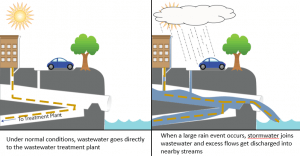Cincinnati’s Unique Approach to Addressing Sewage Pollution: Creating Multiple Community Benefits
Written by Erin Wall, River Network
At scales ranging from the neighborhood and city to the watershed and basin, communities around the country are finding ways to break down silos in water management to become more sustainable and to more equitably maximize benefits across their community and watershed. River Network is hosting a series of webinars with support from the Urban Waters Learning Network and the Pisces Foundation on Integrated Water Management, which cover multiple examples of how these approaches are taking root across the country. The most recent webinar, Sewage Pollution as a Catalyst for Integrated Water Management – Creating Multiple Benefits for Your Community and River, featured Chris Sturm with New Jersey Future and MaryLynn Lodor, Deputy Director with the Metropolitan Sewer District for Greater Cincinnati (MSDGC), who highlighted the innovative work being led by Cincinnati to eliminate combined sewer overflows and succeed in achieving the “triple bottom line” of environmental, social, and economic benefits.
There are 772 cities in the United States that have combined sewer system where sewage and wastewater are combined with stormwater during rain storms. When the volume of the combined flows exceeds the capacity of the local water treatment plant, the flows of raw and partially-treated sewage are discharged directly into local rivers and streams posing a serious threat to local water quality and community livability.

Credit: Metropolitan Sewer District of Greater Cincinnati
In Cincinnati, local rivers and streams receive 11 billion gallons of combined sewer overflows (CSOs) each year, placing Cincinnati in the top five cities in the country for combined sewer overflows. Under the Clean Water Act, a Federal Court consent decree was approved in 2010 requiring the Metropolitan Sewer District of Greater Cincinnati (MSDGC) to reduce combined sewer outflows by 1.78 billion gallons each year.
When the city of Cincinnati first went about finding ways to meet this mandate, they learned that the U.S. Environmental Protection Agency (USEPA) default for a reduction in CSOs is a large underground tunnel that collects CSOs and leads to the treatment plant. While this tunnel would effectively reduce CSOs, the MSDGC uncovered some disadvantages:
- It is limited in its capacity – once it’s full, it’s full
- It is very costly – $500 million – 2x the expected cost!
- It is not adaptable for future needs – what if more infrastructure is needed in subsequent years?
- It does not provide many community engagement opportunities – if community members aren’t engaged, they won’t be invested personally
Given these constraints, MSDGC staff wondered if a sewer project could be more than a sewer project. They asked themselves, “Is there alternative that would be more locally desirable, cost effective and provide more opportunities for the community than an underground tunnel?” While a number of communities across the country have started to use green infrastructure to reduce CSOs, it is still not yet the norm.
However, with some innovative thinking and meetings with community partners, like Groundwork Cincinnati and others, and regulators, the MSDGC conjured up a solution to address their needs. The result is a watershed based approach that uses a combination of different techniques that takes many factors into account – water quantity and quality issues, built and natural environment, current economic conditions, and community engagement. It involves a suite of projects that include both gray and green infrastructure and would cost about half the amount of the underground tunnel. In May 2013, the Lower Mill Creek Sustainable Watershed Solution was approved by U.S. EPA and state regulators.
One component of the broader and more integrated watershed solution is the Lick Run Greenway, a designed urban waterway that mimics natural waterways, including daylighting part of a buried stream. This urban waterway includes debris and sediment separators, natural conveyance systems, detention basins, and green streets and recreation areas. While these techniques are not new, their combination into one single integrated project makes this an innovative initiative innovative to providing multiple benefits while helping reduce CSOs.

Lick Run Greenway plan. Credit: MaryLynn Lodor, Metropolitan Sewer District of Greater Cincinnati
The Lick Run Greenway complies with EPA requirements, uses stormwater as a community resource, improves water quality, and creates new jobs for the community all while being the most cost effective option. This project has catalyzed other green infrastructure projects in the area through new partnerships with schools, local non-profits, and even the zoo.
Integrated water management projects such as the Lick Run Greenway has much more to offer communities than a reduction in sewer overflows and water quality benefits alone – it is an example for integrated water management and serves as an inspiration to cities wanting to achieve environmental, social, and economic benefits. As more areas become affected by extreme weather events due to climate change, taking action and careful planning will become essential to protecting our neighborhoods and watersheds.
For more information on integrated water management and take part in peer to peer discussions, please contact Katherine Baer.
Learn More:
- River Network Integrated Water Management
- River Network webinar Sewage Pollution as a Catalyst for Integrated Water Management – Creating Multiple Benefits for Your Community and River
- River Network webinar Integrated Water Management – What Is It and How Can It Benefit Your Community and River?
- MSDGC, About the Lick Run project and others as part of the consent decree





[…] Image source: River Network […]